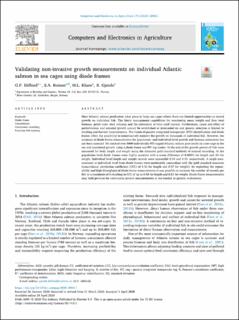| dc.contributor.author | Difford, Gareth Frank | |
| dc.contributor.author | Boison, Solomon Antwi | |
| dc.contributor.author | Khaw, Hooi Ling | |
| dc.contributor.author | Gjerde, Bjarne | |
| dc.date.accessioned | 2020-07-03T06:57:21Z | |
| dc.date.available | 2020-07-03T06:57:21Z | |
| dc.date.created | 2020-06-30T09:22:03Z | |
| dc.date.issued | 2020 | |
| dc.identifier.citation | Computers and Electronics in Agriculture. 2020, 173 1-8. | |
| dc.identifier.issn | 0168-1699 | |
| dc.identifier.uri | https://hdl.handle.net/11250/2660618 | |
| dc.description.abstract | Most Atlantic salmon production takes place in large sea cages where there are limited opportunities to record growth on individual fish. This limits management capabilities for monitoring mean weight and thus total biomass, pellet sizes, feed volumes and the estimation of time until harvest. Furthermore, cause and effect of perturbations and arrested growth cannot be established or interceded on and genetic selection is limited to stocking and harvest measurements. The fusion of passive integrated transponder (PIT) identification and diode frames offers the possibility to noninvasively monitor the growth on thousands of individual fish. However, the accuracy of diode frame measurements for population- and individual level growth and biomass estimation has not been assessed. We stocked over 5000 individually PIT tagged Atlantic salmon post smolts in a net-cage in the sea and monitored growth using a diode frame and PIT tag reader. At the end of the growth period all fish were measured for body length and weight using the intensive gold standard methods of manual recording. At the population level diode frames were highly accurate with a mean difference of 0.002% for length and 4% for weight. Individual level length and weight records were repeatable 0.34 and 0.35, respectively. A single measurement at individual level from diode frames were moderately concordant with the gold standard measures (concordance correlation coefficient (CCC) of 0.52 for length and 0.57 for weight). By exploiting the repeatability and high throughput of diode frame measurements it was possible to increase the number of records per fish to a maximum of 5 resulting in CCC of up to 0.88 for length and 0.81 for weight. Diode frame measurements may hold promise for continuous growth measurements at sea needed in genetic evaluations. | |
| dc.language.iso | eng | |
| dc.title | Validating non-invasive growth measurements on individual Atlantic salmon in sea cages using diode frames | |
| dc.type | Peer reviewed | |
| dc.type | Journal article | |
| dc.description.version | publishedVersion | |
| dc.source.pagenumber | 1-8 | |
| dc.source.volume | 173 | |
| dc.source.journal | Computers and Electronics in Agriculture | |
| dc.identifier.doi | 10.1016/j.compag.2020.105411 | |
| dc.identifier.cristin | 1817714 | |
| dc.relation.project | Norges forskningsråd: 267650 | |
| cristin.ispublished | true | |
| cristin.fulltext | original | |
| cristin.qualitycode | 2 | |
